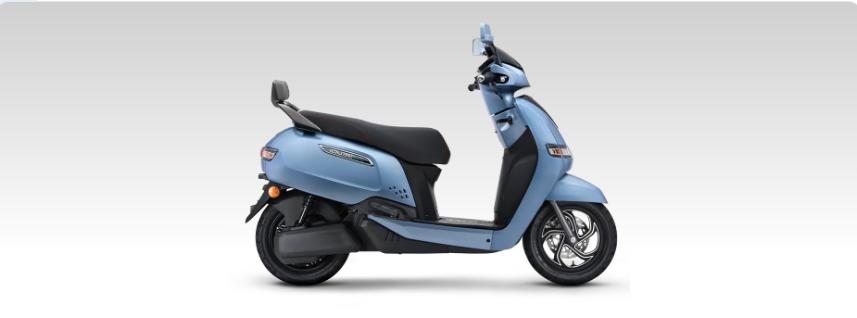TVS Motor is firing up the next phase of India’s electric mobility march. CEO K. N. Radhakrishnan recently revealed during the Q1 FY26 earnings call that the company plans to launch a new entry-level electric scooter and a 3-wheeler by the end of 2025.
Table of Contents
⚡ Why This Matters: TVS Wants More Room in the EV Market
TVS has dominated India’s electric two-wheeler scene for months now. With the iQube portfolio commanding over 24% market share in June and scaling more than 70,000 units in Q1, they’re clearly on a winning path.
So now, moving down-market with a cheaper scooter and branching into electric 3-wheelers feels like the logical next step. They say, “Let’s give more Indians a chance to go electric.”
🚲 The New Scooter: What We Know (or Think We Know)
- TVS is preparing something cheaper than the iQube, possibly a new “iQube Lite” or a totally new model. Think ₹90K–₹1.1L ex-showroom, making it way friendlier to price-sensitive buyers.
- Specs aren’t out yet, but expect a simplified UI, smaller battery, fewer frills—still packed with durability and TVS’s solid ride experience.
- They’ve sold around 600,000 iQube units since launch, so this just adds more reach. (Hint: expect almost everything hardware-smart except the high-end modes in iQube ST.)
🚛 Next Stop: Electric 3-Wheeler
What’s really exciting is the upcoming electric 3-wheeler, possibly a successor to the TVS King EV Max.
- Expect it mid to late 2025, with strong specs—179 km range, fast charging, modular battery packs, fleet-friendly features.
- Probably built for delivery fleets, auto-rickshaw drivers, and small-town logistics partners.
- TVS’s tie-up with Kadam Mobility—already running e-3Ws—signals they’re planning for scale.
🚀 Why This Expansion Is Smart Business
- Fill pricing gaps: A cheaper scooter lets more buyers go electric, especially younger first-time owners.
- Higher EV penetration: Moving beyond premium units means “electric” becomes normal, not aspirational.
- A fleet play: 3-wheelers are essential in deliveries—TVS isn’t skipping that lane, and they have the infrastructure muscle to capture it.
🧾 How the Current iQube Lineup Looks in a Nutshell
| Model | Battery | Range (~IDC) | Price (₹ ex-showroom) |
| iQube (2.2 kWh) | 2.2 kWh | ~75 km | ~94,999 |
| iQube (3.1 kWh) | 3.1 kWh | ~123 km | ~1.03–1.04 lakh |
| iQube S (3.5 kWh) | 3.5 kWh | ~145 km | ~1.27 lakh |
| iQube ST (5.3 kWh) | 5.3 kWh | ~212 km | ~1.57 lakh |
Now add an even more affordable variant and a full cargo 3-wheeler, and you’ve got coverage from ₹90K to ₹1.5L+.
🎯 What Riders and Fleet Owners Should Know
- Urban riders: A more affordable scooter means more people stay closer to the Ather or Ola crowd—without bleeding cash.
- Fleet operators: A smart, electric 3-wheeler could revolutionise last-mile logistics in tier-II cities—not to mention fuel savings.
- Current iQube users: Expect price rationalisation and increased support with a broader dealer network.
🤝 Competition & Positioning
TVS’s move pressure-tests brands like Ola, Ather, Pure EV, and even Bajaj’s Chetak. While Ola may offer sportier models, and Ather, better software polish, TVS counters with reliability, production scale, and longstanding market trust.
🗣️ What Auto Analysts Are Saying
Industry watchers see this as TVS doubling down on EV leadership. With iQube’s performance and smart plays, they believe TVS is carving out a dominant spot across segments—not just high-end scooters. Their Q1 revenue jump of over 20% and profit surge make it clear: India’s EV wave still has room for many riders, and TVS plans to capture more of it.
🛍️ Will These Models Live Up to the Hype?
If TVS keeps its pricing sensible and avoids overpromising features, it can’t:
- The new scooter will attract daily riders who previously thought EVs were beyond reach.
- The electric 3-wheeler could become the delivery partner of choice for startups and small businesses.
- Taken together, these launches shift EV momentum from “alternative niche” to mainstream mobility strategy.
✅ Bottom Line
By year-end, TVS is expected to deliver more than just a new scooter or 3-wheeler—they’re delivering a more accessible EV ecosystem. And given India’s electric mobility ambitions, this expansion may well set the template for how automakers broaden their EV play from metro lanes to every familiar corner of the country.
If you’re watching the EV market, keep an eye on TVS—it’s not just about specs anymore. It’s about strategy, reach, and the story of turning two wheels and three into everyday, cleaner transport.
🙋 FAQs
When are the new TVS EV products likely to launch?
TVS plans to launch both the new electric scooter and the electric 3-wheeler between September and December 2025.
How much will the new scooter cost?
Reports suggest it may be priced between ₹90,000 and ₹1.10 lakh (ex-showroom), making it more affordable than the current iQube variants.
What is special about the new electric 3-wheeler?
It is expected to feature modular batteries, over 170 km range, fleet-specific controls, and be optimised for cargo and last-mile delivery use.
How strong is TVS’s EV footprint right now?
TVS commands over 24% of electric two-wheeler sales, consistently leading the market by volume.
Will these new launches help compete with Ola or Ather?
Definitely. A broader product line with more affordable pricing and electric 3-wheelers puts TVS in a solid position against both Ola and Ather.
Discover more from NEXTWHATBUSINESS
Subscribe to get the latest posts sent to your email.



